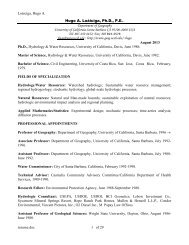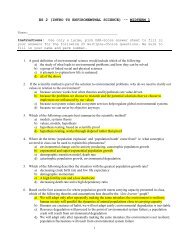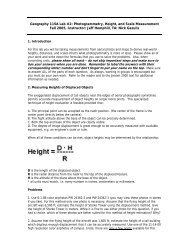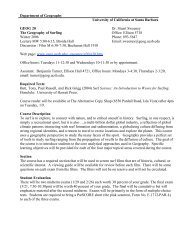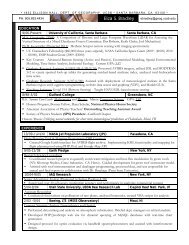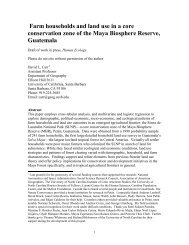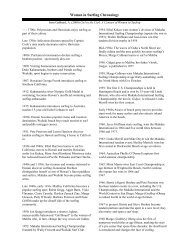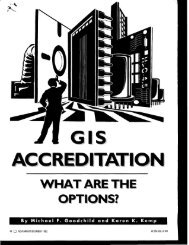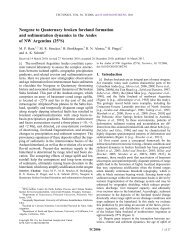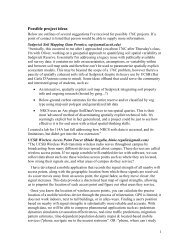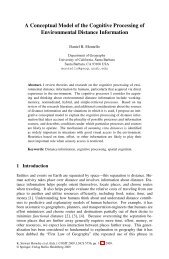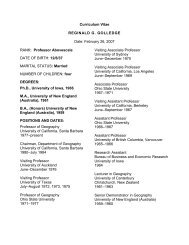Spatial knowledge acquisition from direct experience in the ...
Spatial knowledge acquisition from direct experience in the ...
Spatial knowledge acquisition from direct experience in the ...
You also want an ePaper? Increase the reach of your titles
YUMPU automatically turns print PDFs into web optimized ePapers that Google loves.
102 T. Ishikawa, D.R. Montello / Cognitive Psychology 52 (2006) 93–129<br />
distance between <strong>the</strong> two landmarks to <strong>the</strong> standard distance. Route distances (along <strong>the</strong><br />
test routes) and straight-l<strong>in</strong>e distances (across <strong>the</strong> test routes) were estimated on separate<br />
sheets. The response l<strong>in</strong>es were suYciently longer than <strong>the</strong> standard l<strong>in</strong>e so that participants<br />
had plenty of room to overestimate as well as underestimate.<br />
2.2.4. Map sketch<strong>in</strong>g task<br />
Dur<strong>in</strong>g even-numbered sessions, participants were given an 8.5 £ 11 <strong>in</strong>. blank sheet of<br />
paper and drew a sketch map of <strong>the</strong> routes, show<strong>in</strong>g <strong>the</strong> four landmarks on each route and<br />
<strong>the</strong> shapes of <strong>the</strong> routes.<br />
2.2.5. Self-report sense-of-<strong>direct</strong>ion<br />
Participants Wlled out <strong>the</strong> Santa Barbara Sense-of-Direction (SBSOD) Scale, which was<br />
developed and validated by Hegarty et al. (2002). It consists of 15 statements to which participants<br />
express <strong>the</strong>ir degree of agreement on a 7-po<strong>in</strong>t Likert scale. Seven of <strong>the</strong> questions<br />
are stated positively (e.g., “I am very good at giv<strong>in</strong>g <strong>direct</strong>ions”) and <strong>the</strong> o<strong>the</strong>r eight negatively<br />
(e.g., “I very easily get lost <strong>in</strong> a new city”).<br />
2.3. Design<br />
Six participants were randomly assigned to each of four conditions with respect to two<br />
experimental factors: (a) whe<strong>the</strong>r <strong>the</strong>y traveled each route twice <strong>in</strong> one <strong>direct</strong>ion (uni<strong>direct</strong>ional)<br />
or once <strong>in</strong> both <strong>direct</strong>ions (bi-<strong>direct</strong>ional); and (b) whe<strong>the</strong>r <strong>the</strong>y started <strong>from</strong> Trees<br />
on <strong>the</strong> U-route and Sunburst Gate on <strong>the</strong> S-route, or <strong>from</strong> Red Brick Wall on <strong>the</strong> U-route<br />
and Lamps on <strong>the</strong> S-route. In each condition, <strong>the</strong> order of present<strong>in</strong>g <strong>the</strong> two routes was<br />
counterbalanced: half <strong>the</strong> participants traveled <strong>the</strong> U-route Wrst and <strong>the</strong> o<strong>the</strong>r half traveled<br />
<strong>the</strong> S-route Wrst.<br />
2.4. Procedure<br />
On a separate day before <strong>the</strong> experimental sessions began, <strong>the</strong> experimenter (<strong>the</strong> Wrst<br />
author) met participants <strong>in</strong>dividually <strong>in</strong> his oYce and expla<strong>in</strong>ed <strong>the</strong> outl<strong>in</strong>e of <strong>the</strong> experiment.<br />
Participants practiced estimat<strong>in</strong>g <strong>direct</strong>ions and distances (both route and straightl<strong>in</strong>e)<br />
us<strong>in</strong>g places on campus as examples. After practice, <strong>the</strong> experimenter ensured that<br />
participants completely understood what and how <strong>the</strong>y would estimate. They next Wlled<br />
out <strong>the</strong> SBSOD questionnaire. F<strong>in</strong>ally, participants signed a form promis<strong>in</strong>g <strong>the</strong>y would<br />
nei<strong>the</strong>r personally visit, nor look at a map of, <strong>the</strong> study area dur<strong>in</strong>g <strong>the</strong> period of <strong>the</strong> study,<br />
even if <strong>the</strong>y happened to know where it was. This was important for controll<strong>in</strong>g <strong>the</strong><br />
amount and method of exposure to <strong>the</strong> environment.<br />
Participants took part <strong>in</strong> an experimental session <strong>in</strong>dividually, once a week for 10 consecutive<br />
weeks. The experimenter drove a car with <strong>the</strong> participant seated <strong>in</strong> <strong>the</strong> passenger<br />
seat throughout <strong>the</strong> session. The experimenter kept <strong>the</strong> car’s speed constant at 30 miles<br />
(48 km) per hour throughout <strong>the</strong> session, with only m<strong>in</strong>imal deviations that were unavoidable.<br />
At <strong>the</strong> beg<strong>in</strong>n<strong>in</strong>g of every session, before go<strong>in</strong>g to <strong>the</strong> study area, <strong>the</strong> experimenter<br />
showed participants <strong>the</strong> standard distance; participants were driven between two streetlights<br />
twice <strong>in</strong> opposite <strong>direct</strong>ions and told to memorize how far <strong>the</strong>y were apart for later<br />
use <strong>in</strong> distance estimation. Then participants put on a bl<strong>in</strong>dfold and were driven to <strong>the</strong><br />
study area.



